Hello. My name is Dmitry Gutov. I am an artist from Moscow. In the
following 30 minutes I will be your guide in the Boijmans Van Beuningen
museum. My project is made as a work for Manifesta 1, which is currently
being held in Rotterdam. We are going to head towards the big round
place, then turn to the right, and make our way up the staircase to
the hall of the old Netherlands painters.
We will start our excursion from one of the best works in this museum:
on the left wall, in the center, there is a canvas by Van Eyik "Three
Maries at the tomb".
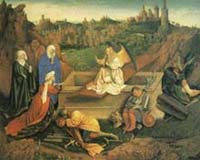
To tell you the truth, I am interested only in one question: What
kind of art is possible today? Or, to be more precise: what does the
world look like in the second part of nineties?
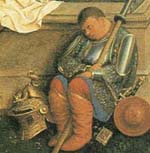
Let's get closer to this painting and look at the face of the sleeping
soldier. Here he is in metal body armor. A slightly puffy face. Puffs
under the eyes. The main discovery here lies in the fact that misery
is shown very poetically. The character has overslept the greatest
event - God's Resurrection.
I think that such point of a view is the only possible nowadays. When
a man has become as miserable as ever. He needs the most sublime attitude.
A helmet at his feet is painted fantastically! With the shining of
tiny red and blue pebbles.

Let's look to the left, at the bottom of the picture. A plant with
yellowish flowers. These blades of grass everywhere. This total trust
towards the surface of things, their real form. We have crossed the
border from which it was possible to criticize the world, to accuse
it. Nowadays we can only adore it.

Now I should like to show you one more work in this hall, if you turn,
on the opposite wall, to the left of the door. Here is a work of Dirk
Bouts "St John". A red figure on a green background. The
foot is painted a touch too dry. While painting the grass around the
feet, the brushwork was moving too mechanical. This is only the beginning
of moving away from van Eiyk. Its unresolved quality led to monotony
and stillness, which flourished in the XX th century. Now, at the
end of the century they became foreign to our eye.
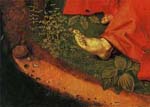
But the stones underneath are wonderful. As well as the transparent
edge of the water. It is quite a modern piece.
Now we will go to the next hall. The door to the right of St John.
We are going through it to the left door. Unfortunately we have no
chance to see all the works. And now we enter hall number three. On
the right wall you can see a painting by Bosch "Saint Christophorus".

The story of a giant, who helped people to cross the river and who
once carried the baby Christ on his shoulders. From the distance the
picture exudes harmony, but if we come closer we will see that it
is full of sad delirium. On the right there is a tree where a fox
is hanging by the tail.

On the left, a man has thrown his arbaleth and is hanging a bear.

Everything is sharp and fresh. The absurdity of what is happening
is painted in a manner and technique, discovered for the sake of a
different goal. That is the shining of tones and transparency. The
technique of oil painting had been developed in order to describe
the poetics of the world and not its dissolution. But this separation
has been consuming itself during 500 years of self-improvement. The
epoch where it was possible to appreciate an artist's work with an
exclamation "It's crazy!" is passing in front of our eyes.
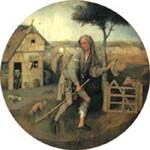
To the left of "Christophorus" is "Peddler". The
composition forms a circle. Its making conforms to the rules of color
and compositional harmony. The understanding of the motives behind
a person's deeds, the one who has lost his inner calmness. Thousand
expressions are floating over his face.

But 50 years had passed after van Eyik and then the artist had to
pay for all his achievements. The price is the deep pessimism of a
moralist, punishing the world for its sins. Such rhetoric were still
possible in the works of 1970-s, but it is absolutely unacceptable
now. The world is so decayed that there doesn't exist a point of view
from which we can see it that way.
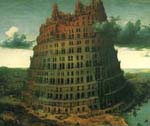
Now, if we turn to the left there is Breigel's work "Babylon
tower" on the central wall. The finest commentary to this work
are those pages of Marx's "Capital" where he writes about
factories in England in the XVI th century. The main forces in a man
are uncovered, his possibilities become enormous but he turns into
misery. Breigel finds the ideal distance where we can see the greatness
of everything happening and the insignificance of a man.

Here we see a similarity to Van Eyik in the astonishing attention
to small details. It was not necessary for Breigel when he painted
natural peasants' life. The price Breigel had to pay for his genius
is the allegorical character of the image. Its constant use has turned
into vague symbolic and a system of ciphered statements, which were
so much loved in the XX th century.

If we turn and come to the glass showcase, we will see a small beautiful
still life. Here high poetics are combined with the real images of
objects. And that is modern. The epoch of delirium has finished. The
sensitive surface of the world is again fresh and it can cheat nobody.
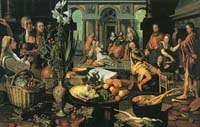
Now we are moving to another hall. To the door on the right. A big
canvas is on the wall. This is Peter Aertsen. A picture where we can
see the features of decline isn't very interesting now. As well as
mannerism or Pre-Rafaelits. It was popular to adore it in the epoch
of decline. Now there is no decline as there is nothing to rot. That's
why Michelangelo's opinion towards such painting is so close to us.
Thus, he said: Only those people like it who doesn't feel any sensitive
harmony. Even if it is very pleasant for the eye, there is neither
sense, nor symmetry, nor proportions: there is neither choice nor
greatness. Here exists neither power, nor beauty. I think it is a
very modern point of view.

And now if we turn and come to the nearest glass stand, we will see
a small picture on the right. This is Bosch. The fragment of his work,
an old woman's face. Unfortunately we can't come closer because of
the glass. A beautiful face, not too ideal but full of natural inner
life.
Now we are turning to the right and going to the next, fifth hall,
representing Rubens' drafts
.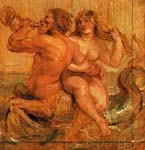
We are going slowly along the right wall. Looking at the works. The
main attraction for the collector. The drafts are not spoiled by Rubens'
pupils. A genius needs an orgy. The orgy is a kingdom of freedom.
Liberation of strong and bright desires. Nowadays again a man is standing
in the face of a great situation and a great action. That's why Rubens
is so close to him.
Now we are going to another sixth hall. Going through it. Now continue,
through the seventh hall with 17-century landscapes. Let's come into
the hall 8 to see the genre scenes by Jan Steen.
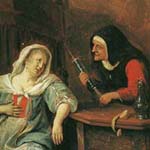
Let's approach the opposite wall, closer to the second work from the
left. Somebody is being operated on the throat here. The world, which
is looking at itself with the artist's eyes, sees that it is quite
disgusting. It is difficult to stand it even having developed the
power of observation. But like a faraway echo of a bright glance of
van Eyik, this scene has the touch of an art of painting. Here is
its content - soft humor like a weak hope for the better future.
In 300 years, when this hope totally disappears, those swabs will
be put into exhibition spaces.
The world is too beautiful for the annihilated person, to pay attention
to such miserable things.
Now we will go through hall number nine, passing Claude Lorrene, Charden,
Vatto. Let's enter into hall 10, in the corner there is a small work
of Gerard Ter Borch "The Spinner".
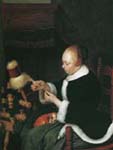
Hegel deeply understood those small pictures. He found in them an
accurate depiction of banal nature and a reflection of the inner honor
of people. Because they had achieved that prosperity themselves. They
conquered the earth from the sea, liberated from Spain, achieving
religious freedom.
Hollanders paid for their art by smallness, even in the size of their
works. But today the world soul doesn't live in this prosaic reality.
It exists only in the great. Because nothing else is left.
Now we are going to the 11th hall and just to the left we can see
two portraits by Rembrandt. We will approach the right portrait of
a boy.
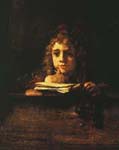
Rembrandt is full of the same high and mighty feeling which had been
stimulating van Eiyk. But in the 17th century, one had to pay more
for the ability to see the world in such way. Hot light is burning
the cold part of the palette, all green and blue shades. The impaste
is forced, it gets its own history which terminates with the transformation
of the picture into an object. But today there is no longer price
which could buy you such point of view on life. It could only be presented
without any efforts.
Now let's move to the next exit, crossing this big hall and passing
through the enfilade. Still-lives, portraits and genre scenes are
floating beside us. Go further. We are going to the opposite exit
and come to hall 37. We enter into this hall and on the right in the
center of the wall we see a small portrait.

Let's come to it as close as possible. The face is of astonishing
dignity. It lacks any occasional features. His gaze is calm, not concentrated,
and full of human attitude towards life.
That is the understanding of greatness of a human being which, I think,
constitute today's life.
That is the way to paint - simply and sublime. How is it possible
to make installations after this.
Now we shall turn to the right, and go through the nearest door and
into the hall, which we have just passed. Immediately on the right
there is a Titian "A Boy in Pink with a Dog".
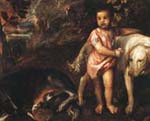
He resists trivial characterizations through a variety of painting
methods. Titians great discovery was in the expression he attained
through the movement of his brush. This non-adherence to strict contours
has its own history the extremity of which was the total elimination
of image.
Another exemplary work in this hall is in the glass showcase occupying
the center. We shall approach it from the left. A portrait of a boy
by Veronaise.
How many natural and beautiful emotions he has. A living and thinking
creature could be easily insulted - but any insult has its limits.
When these limits are surpassed a persons face can again become radiant.
Now we shall go to the right, through the door and into hall 17. There
are two dark works to the right of this passage, this is Onoray Dormier.
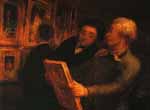
To the right is "The Amateurs". The truthful image of the
19th Century was not picturesque and the artist had to struggle with
the strong intention of his will. He refuses to represent the faces
of these monsters.
We are going to go to hall 19, do not stop. On the left there is
Claude Monet who blurred his vision so as not to focus on this misery.

Then we turn to the left to hall 26. We pass Man Ray, Magritte, Dali,
DeChirico - an art of a disappearing epoch the language of which is
becoming more vague.
Carrying on into hall 26 pass Picabia we go into hall28. Ahead of
us there is a picture. A girl is lying. Broken matches. Numerous needles.
The boredom and senseless existence of the 1970s. How distant these
things are from us.
We pass hall 29 with abstract art and go into hall 30 passing Kandinsky
and open the door onto the hall where we can recognize a work by Donald
Judd.
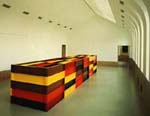
When was it? This idea that nothing exists in the world besides primal
elements, all this contrasting of living and mechanical, outer and
inner, sense and senseless. Those were the discovered methods to discuss
an inexpressive world. But today the world is expressive and these
ideas have lost their meaning.
We shall go through the long corridor and again turn to the right.
Enter the hall where there are four projections around us by Bruce
Nauman call rotating glass walls, Let's approach one of the walls
to see the trembling movement. It's not Van Eyke or Veronaise. This
is a representation of our world, which cannot be put in a proper
form. But it has one big weak point. It is too close to the original.
We need some distance (as in Breugel's Tower) to understand the impossibility
of the incident of the reality which is one big event in itself. Besides
it is very expressive.
Now lets go to the corridor and turn to the right where we shall meet
Hans Haacks work. There you will see the storage of the world art.
It does not seem to me storage but a drama. With a very clear plot
which will never be finished.
Now I shall bid you farewell. Thank you very much for your attention.
I am very grateful to all those who gave me a chance to work in the
Museum. Among wonderful masterpieces of a human hands and minds.